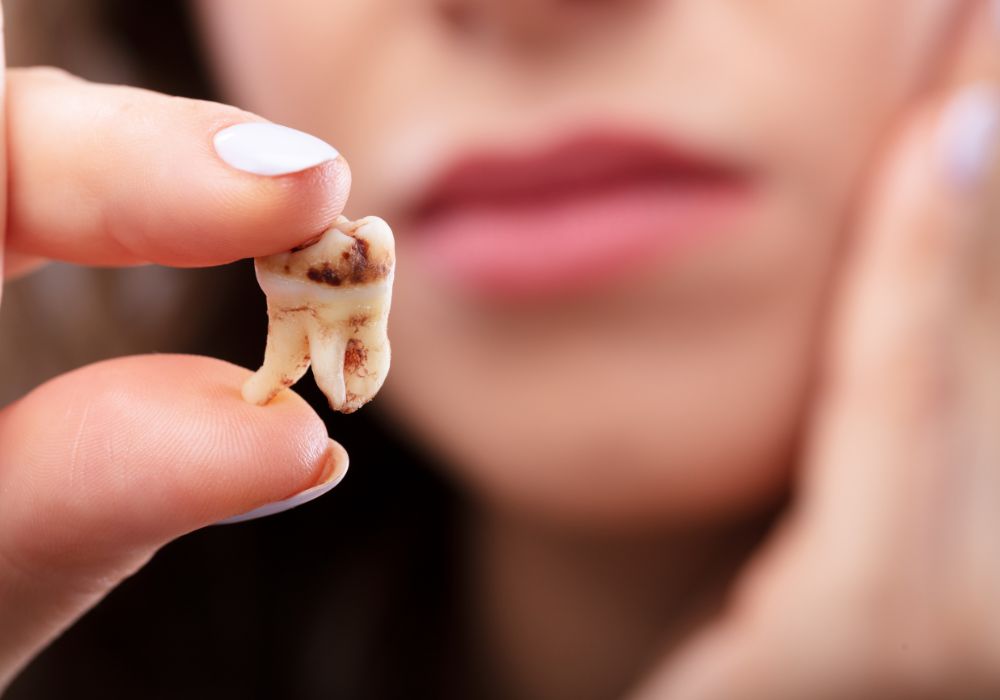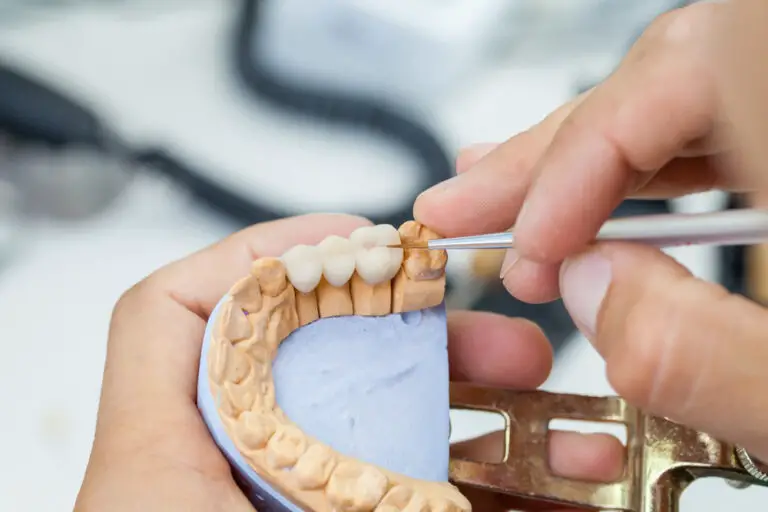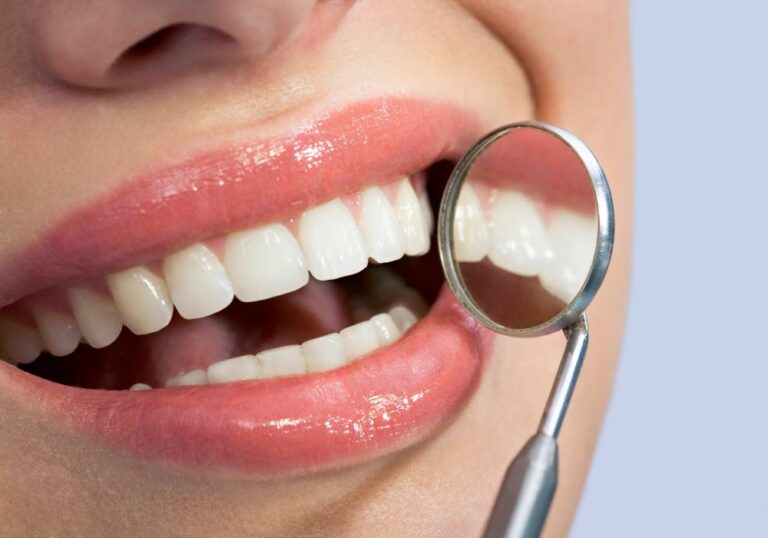What is a cavity and what causes it?
A cavity is a localized area of tooth decay that forms when acids erode through the hard enamel surface of a tooth. Cavities are also referred to in dentistry as dental caries.
Cavities develop as a result of bacterial action on the teeth. The oral cavity contains over 700 varieties of bacteria, the most cariogenic (cavity-causing) types being Streptococcus mutans and Lactobacillus.
After consuming sugary or starchy foods, remnants are left behind on the teeth. This debris is metabolized by bacteria in the dental plaque coating the teeth, producing acids as a byproduct. Common acids produced include lactic, acetic, and propionic acids.
These acids proceed to dissolve the mineralized structure of tooth enamel in a process called demineralization. The enamel contains high amounts of calcium and phosphate minerals organized into crystal formations. The plaque acids break down and dissolve these mineral crystals, weakening the enamel structure.
At first, the acid exposure only strips minerals from the enamel surface. These earliest lesions are called white spot lesions or early caries. Though the enamel looks intact, subsurface demineralization has begun. At this stage, remineralization treatment can help replenish minerals and reverse the lesions.
But with repeated and prolonged acid attacks, the erosive process penetrates deeper into the enamel rods and eventually reaches the underlying dentin layer. As the decay spreads, it forms a small hole or pit in the enamel surface. This is classified as a cavitated lesion or true dental caries. Now, restoration is required to fill in the defect.
Left untreated, bacteria and decay debris spread through the open cavity down towards the soft dental pulp. Eventually, the pulp tissue becomes irreversibly damaged and infected as well.
Several factors significantly increase an individual’s risk of developing cavities:
- Poor oral hygiene – Inadequate brushing and flossing allows plaque thickly coat the teeth and release acids.
- High-sugar diet – Frequent consumption of sugary foods and beverages promotes acid production and enamel demineralization.
- Reduced saliva flow – Saliva contains minerals and helps buffer plaque acids. Conditions like dry mouth increase cavity risk.
- Deep tooth pits/fissures – The chewing surfaces of back teeth are highly indented and collect food and plaque easily.
- Enamel defects – Thin, weak, or improperly formed enamel is less resistant to acid dissolution.
- Orthodontic appliances – Braces and retainers make plaque removal more challenging.
- Older dental restorations – Fillings, crowns, and veneers accumulate more plaque if not properly cared for.
What are the symptoms of a cavity?
A developing cavity may not produce any obvious symptoms in its earliest stages, when demineralization is confined to the enamel’s outer surface. That’s why routine dental exams and x-rays are imperative for early detection and treatment.
As the decay penetrates deeper into the tooth, reaching the inner dentin layer, symptoms often begin to arise. Possible signs and symptoms include:
- Tooth sensitivity – brief, sharp pain when consuming hot, cold, sweet, or acidic foods/drinks.
- Pain when chewing or biting down – food presses on the cavity.
- Lingering pain after removing the stimulus – throbbing toothache after eating sugary or hot/cold foods.
- Enamel discoloration – cavities appear as yellow, brown, or black stained spots or lines on the teeth. Early cavities may look like white spots.
- Visible holes or pits in the tooth surface – ranging from a small pinpoint defect to a large, obvious dark hole.
- Chipping or fracturing of the enamel surface.
- Halitosis (bad breath) emanating from the decayed tooth.
- A persistent bad taste or foul odor in the mouth.
As the decay nears the inner pulp tissue, more severe symptoms arise:
- Spontaneous toothache and pain without provocation – may awaken someone from sleep.
- Prolonged pain after a stimulus is removed – throbbing pain persisting for many minutes after eating/drinking.
- Swelling of gums around the tooth – possible abscess formation.
- Pus discharge from swollen gums.
- Loosening or chipping of the enamel.
- Tooth fracture exposing inner layers.
- Recession of the gums around the tooth.
- Forming a facial swelling or reddened gum boil.
When should you get treatment for a cavity?

It is imperative to get treatment for a cavity as soon as possible once detected. The larger a cavity grows, the more complicated treatment becomes and the poorer the long-term prognosis.
Prompt treatment also prevents irreversible spread of the infection into the tooth pulp and root canals. Preserving the living pulp tissue improves restorative outcomes and prevents complications like abscesses or tooth loss.
See your dentist immediately if you notice any possible signs of a cavity, like pain or sensitivity to foods, visible discoloration or holes in the enamel, cracks or fractures, or unexplained toothache. Don’t delay – early treatment while the decay is localized and before it reaches the pulp offers the best chance of reversing the process before more invasive treatment is required.
Conversely, delaying treatment raises your risk of severe infections, pulpal necrosis, tooth fractures, loss of the tooth, and systemic health issues. In children, unaddressed cavities also disrupt proper permanent tooth development and alignment. Regular dental visits and prompt treatment help prevent such negative outcomes.
What are the treatment options for cavities?
Several factors guide the dentist’s selection of the optimal cavity treatment method:
- Precise size, depth, and location of the lesion
- Extent of spread into deeper tooth layers
- Amount of remaining healthy tooth structure
- Presence of pulpal inflammation or infection
- Stage of tooth development in children
- Overall periodontal condition
- Restorability of the tooth
- Presence of multiple lesions
- Your symptoms and oral health history
Common treatments for cavities include:
1. Fillings
Fillings are the standard solution for mild to moderate decay confined to the enamel and outer dentin. The dentist will first use a drill to remove all decayed material from the cavity, leaving only healthy tooth structure behind. They then fill the cleaned and shaped hole with a bonded filling material.
Options for direct fillings include:
- Gold – very durable and lasting filling material but expensive
- Silver amalgam – affordable but aesthetically displeasing
- Tooth-colored composites – blend in seamlessly for an invisible filling but less durable than gold or amalgam. Common composites include ceramic, porcelain, and plastic/resin based materials like those used in orthodontic brackets.
After drilling out the decay, the tooth is prepped with etching acid and bonding agents to ensure a tight seal. The filling is shaped and hardened using a curing light. The filled tooth is then polished smooth.
Advantages of Fillings:
- Conserve healthy tooth structure compared to crowns
- Simple, relatively quick procedure
- Often completed in one visit for small cavities
- Effective and durable if properly done
Disadvantages:
- Further drilling required with recurrent decay
- Not as strong as crowns for large cavities
- Can chip, crack, or fall out over time
2. Crowns

A dental crown provides a cap or covering over a severely decayed tooth or one requiring a root canal. The crown protects and strengthens what remains of the natural tooth while restoring its shape, function, and aesthetics.
During the first visit, the tooth is prepared by filing down the damaged structure using a drill. Impressions are taken and a temporary crown affixed for the interim period. A dental lab then fabricates a custom crown to fit the prepared nub and match your natural teeth.
At the second appointment, the permanent crown is tried on for proper fit before cementing it in place. Common crown materials include porcelain, ceramic, metal alloys, and zirconia. Though more invasive than a simple filling, a crown is required for a deeply compromised tooth.
Advantages of Crowns:
- Strengthen and preserve a tooth at risk of fracture
- Protect a tooth already requiring a root canal
- Resist future decay better than fillings alone
- Restore form, function, and aesthetics
Disadvantages:
- More costly than a filling
- Additional drilling to shape the tooth for a crown
- Can eventually dislodge or fracture, requiring replacement
3. Root Canal Therapy
If decay reaches the inner pulp tissue or infection sets in, root canal treatment will be necessary to save the tooth. This involves removing the diseased pulp, thoroughly cleaning and disinfecting the root canal system inside the tooth roots, and sealing the space.
A temporary crown is placed while you heal. A follow-up visit to permanently restore the tooth with a crown is required after to prevent fracture. Though root canals have a reputation of being painful, modern techniques allow them to be performed relatively comfortably with local anesthetic.
Advantages of Root Canals:
- Over 90% success rate in retaining severely compromised teeth
- Preserve your natural tooth rather than extraction
- Resolve acute dental pain and infection
- Avoid need for dental implant or bridge
Disadvantages:
- Multiple appointments required
- Crown required afterward to prevent tooth fracture
- Risk of complications like reinfection or apical periodontitis
- Can eventually fail, requiring extraction
4. Tooth Extraction
When decay is severe and a tooth cannot be adequately restored with other methods, extraction may be necessary. This is often a last resort when root canals and crowns cannot rectify the level of damage.
The dentist will numb the tooth and surrounding tissues. Using specialized dental instruments, they will then carefully detach the tooth and root from the socket and remove it fully intact when possible. Stitches may be placed to encourage socket healing.
The resulting gap can be left empty or later treated with a dental implant or bridge. Impactions often require oral surgery techniques for removal. With simple extractions, recovery takes about a week.
Advantages of Tooth Extraction:
- Immediately and permanently removes the source of infection or pain from a non-restorable tooth
- Prevents spread of infection to other teeth/tissues
- Allows implant or bridge placement to restore the gap
Disadvantages:
- Loss of a natural tooth
- Can damage surrounding bone and nerves
- Risk of post-op complications like dry socket
- Gap affects chewing and speech abilities
Can you get decay under crowns or veneers?

Unfortunately yes – the underlying natural tooth beneath a crown or veneer is still vulnerable to recurrent decay over time if not properly cared for. Bacteria, plaque, and foods can leak underneath restorations and infect the remaining enamel. Preventing this requires:
- Maintaining excellent oral hygiene – Brush carefully around the margins of your restorations and floss thoroughly between teeth to remove plaque buildup.
- Regular professional cleanings – A hygienist can clean plaque from interfaces that your toothbrush can’t reach.
- Avoiding excessive sugary and acidic foods/drinks – This deprives bacteria of the carbohydrates they metabolize into enamel-eroding acids.
- Correcting ill-fitting crowns or veneers – Gaps permit leak underneath. Have loose or defective restorations repaired promptly.
- Using fluoride toothpaste and rinses – Fluoride remineralizes tooth surfaces underneath crowns.
- Not grinding or clenching teeth – This can crack restorations and expose margins to bacteria. Consider a nightguard.
With proper home care and regular dental visits, decay around crowns and veneers can certainly be prevented. But be sure to get regular exams – early detection of any recurrent decay allows for a quick filling before it destroys more tooth structure underneath.
How can cavities be prevented?
Preventing cavities centers on restricting the disease factors that put teeth at risk:
- Practice excellent oral hygiene – Brush for 2 minutes, twice daily, using proper technique. Include the tongue, gums and inside surfaces. Floss thoroughly between teeth daily as well. This removes dental plaque before acid-producing bacteria colonize and proliferate.
- Reduce sugar consumption – Limit sugary and starchy foods that provide fuel for the bacteria’s acid production. Avoid constant snacking and sipping of sweets. Rinse with water after sugary snacks. Choose healthy whole food options naturally low in refined carbs.
- Use fluoride toothpaste and rinses – Fluoride incorporated into dental enamel makes it more acid resistant. Use fluoride toothpaste and over-the-counter rinses. Your dentist may prescribe higher concentration fluoride therapies like gels or varnishes.
- Drink fluoridated water – Water fluoridation helps prevent cavities via remineralization. If your local water supply doesn’t contain fluoride, drink fluoridated bottled water instead.
- Eat tooth-healthy foods – Focus diet on fruits, vegetables, proteins, cheeses and nuts that help cleanse the mouth after eating. Avoid excessive citrus, berries or other erosive acids.
- Avoid tobacco use – Smoking and chewing tobacco increase your risk of gum disease, enamel erosion and oral cancer – all risk factors for cavities. Quitting tobacco is essential for good oral health.
- Visit the dentist regularly – Get professional cleanings every 6 months and exams to detect early decay when it’s easiest to treat.
Your dentist may also recommend dental sealants for deep grooves on posterior teeth, antimicrobial mouth rinses, vitamin/mineral supplements or prescription-strength fluoride applications based on your specific cavity risk factors. With diligent daily care and consistent professional cleanings, you can prevent cavities from ever developing in the first place!
Here are 5 expanded questions and answers about treating cavities:
Q1: If a small new cavity is detected early, can it be reversed before it requires a filling?
A1: Possibly yes, in some circumstances where decay is detected at its earliest stages. If demineralization is localized to a white spot lesion on the enamel surface, remineralization therapies can help rebuild minerals and arrest the cavity’s progression so a filling may not be immediately necessary.
The dentist will first scrape away the softened enamel using hand instruments or a dental laser. They can then apply fluoride varnish, prescription paste, or other remineralizing materials to the micro-abrasion site. Reducing your sugar intake, improving oral hygiene, and coming for frequent fluoride treatments may reverse the lesions before they require traditional fillings.
Q2: How does a dentist reach cavities located between back teeth to fill them?
A2: Treating interproximal cavities between posterior teeth requires special techniques to gain access and visibility. The dentist will first numb the area using dental anesthesia. They wedge a piece of wood or plastic between the teeth to push them slightly apart. Using an angled dental mirror and probe, they can visualize between the teeth.
The decay is removed using a dental bur drilling from the outer surface, by drilling through the biting surface of the tooth, or sometimes by entering from the back side of the adjacent tooth. The cavity is then packed with a temporary filling for a week to allow the gums to heal. On a follow up visit, the final resin composite filling is sealed into place between the teeth.
Q3: If left untreated, can cavities eventually lead to losing the tooth completely?
A3: Yes, without treatment, cavities progressively destroy the tooth structure leading to serious complications:
- Cavities spread inward toward the pulp tissue, infecting the nerves and blood supply. This causes extreme, spontaneous pain and abscess formation in the roots.
- Loss of pulp vitality leads to brittleness and cracking of the remaining tooth crown.
- Bacterial toxins and infection disseminate through the root canal system and jawbone, threatening surrounding teeth.
- The tooth becomes so severely compromised that extraction is ultimately required, especially once infection spreads to the bone.
In fact, tooth decay resulting in complete tooth loss represents the #1 reason for permanent tooth extractions. This underscores how vital early cavity detection and prompt treatment is for proper long-term dental health and retaining your natural teeth.
Q4: What steps promote healing after getting a cavity filled by the dentist?
A4: Follow these tips to help your tooth heal after a filling procedure:
- Take over-the-counter pain relief medication as directed by your dentist to manage sensitivity or discomfort.
- Rinse with warm salt water after meals to keep the area clean.
- Stick to soft foods and chew on the opposite side initially.
- Avoid extremely hot or cold foods/drinks which could aggravate sensitivity.
- Brush and floss gently around the site for the first few days.
- Sensitivity to hot/cold liquids typically improves within a few weeks as the area heals.
- Use desensitizing toothpaste if sensitivity persists longer.
- Call your dentist if you have fever, chills, swelling, or excessive pain after the anesthetic wears off.
Q5: How frequently do dental fillings need to be replaced?
A5: With proper oral hygiene and routine dental care, resin composite and amalgam fillings normally last 5-10 years before needing repair or replacement. However, many factors affect their longevity:
- Your diet – Frequent exposure to sugar, acids, hard foods quickly degrade fillings.
- Oral hygiene – Poor brushing/flossing leads to secondary decay around restorations.
- Occlusal forces – Grinding or clenching splits or dislodges fillings.
- Location – Fillings in posterior teeth withstand chewing forces better than anterior ones.
- Materials used – Gold and porcelain fillings last the longest overall.
To maximize filling lifespan, maintain meticulous home care and avoid tooth-damaging habits. Get exams/cleanings every 6 months so your dentist can promptly detect and treat any failing restorations.






